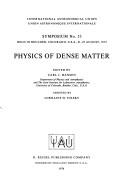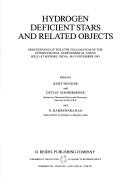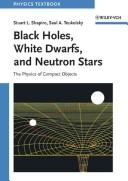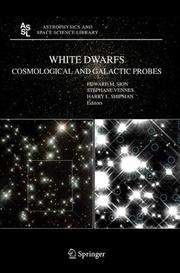| Listing 1 - 10 of 13 | << page >> |
Sort by
|
Book
Year: 1941 Publisher: Paris : Hermann,
Abstract | Keywords | Export | Availability | Bookmark
 Loading...
Loading...Choose an application
- Reference Manager
- EndNote
- RefWorks (Direct export to RefWorks)
Book
Year: 1958 Publisher: Berlin: Springer,
Abstract | Keywords | Export | Availability | Bookmark
 Loading...
Loading...Choose an application
- Reference Manager
- EndNote
- RefWorks (Direct export to RefWorks)
Book
Year: 1991 Publisher: Dordrecht Boston London Kluwer Academic
Abstract | Keywords | Export | Availability | Bookmark
 Loading...
Loading...Choose an application
- Reference Manager
- EndNote
- RefWorks (Direct export to RefWorks)

ISBN: 0030791553 9780030791550 Year: 1973 Publisher: New York Holt, Rinehart and Winston
Abstract | Keywords | Export | Availability | Bookmark
 Loading...
Loading...Choose an application
- Reference Manager
- EndNote
- RefWorks (Direct export to RefWorks)
Astrophysics --- Astrophysique --- Astrophysics. --- Pulsars --- White dwarfs --- Nebulae(Planetary-) --- Stars(Redgiant-) --- Neutron stars --- Supernovae --- Galaxies --- Novae --- Stars formation --- Stars(Variable-) --- Protostars --- Stars physics
Dissertation

Year: 2019 Publisher: Liège Université de Liège (ULiège)
Abstract | Keywords | Export | Availability | Bookmark
 Loading...
Loading...Choose an application
- Reference Manager
- EndNote
- RefWorks (Direct export to RefWorks)
In this work, the emphasis will be placed on the understating of the theory needed to try to describe correctly the interaction between convection and pulsation. We will shed light on important terms appearing due to turbulent flows and see how we can describe them. Hence, we will present more evolved models that should reproduce the reality with a better fidelity. Finally, to illustrate and compare the different possible models introduced previously, we will study a well-known type of variable stars: the ZZ Ceti white dwarfs. These dying stars are known for their extremely thin but efficient convection envelope (as most white dwarfs) and for their instability strip for which better predictions are still needed in order to match the observations. Dans ce travail, l'emphase sera mise sur la compréhension de la théorie nécessaire pour décrire correctement l’interaction entre la convection et les pulsations. Nous mettrons en évidence l'apparition de termes importants supplémentaires provenant des écoulements turbulents et nous verrons comment ils peuvent être décrits. De plus, nous présenterons des modèles plus évolués censés reproduire la réalité avec une meilleure fidélité. Finalement, pour illustrer et comparer les différents modèles que nous auront préalablement introduits, nous étudierons un type d'étoiles variables bien connu : les naines blanches ZZ Ceti. Ces étoiles en fin de vie sont connues pour leur enveloppe convective fine mais très importante et surtout pour leur bande d'instabilité pour laquelle de meilleures prédictions sont toujours nécessaires afin de reproduire les observations.

ISBN: 9027704066 9027704074 Year: 1974 Publisher: Dordrecht ; Boston, MA : D. Reidel,
Abstract | Keywords | Export | Availability | Bookmark
 Loading...
Loading...Choose an application
- Reference Manager
- EndNote
- RefWorks (Direct export to RefWorks)
52 <063> --- Matter --- -Neutron stars --- -Stars --- -White dwarfs --- Compact objects (Astronomy) --- Dwarf stars --- Sidereal system --- Galaxies --- Circumstellar matter --- Stars --- Pulsars --- Atoms --- Dynamics --- Gravitation --- Physics --- Substance (Philosophy) --- Astronomie. Astrofysica. Ruimteonderzoek. Geodesie--Congressen --- Congresses --- Evolution --- -Congresses --- Neutron stars --- White dwarf stars --- -Astronomie. Astrofysica. Ruimteonderzoek. Geodesie--Congressen --- White dwarfs

ISBN: 9027723265 9401086087 9400947445 Year: 1985 Publisher: Dordrecht Boston Lancaster Reidel
Abstract | Keywords | Export | Availability | Bookmark
 Loading...
Loading...Choose an application
- Reference Manager
- EndNote
- RefWorks (Direct export to RefWorks)
52 --- A stars --- -B stars --- -Cool stars --- -Cosmochemistry --- -White dwarfs --- Compact objects (Astronomy) --- Dwarf stars --- Astrochemistry --- Cosmic chemistry --- Space chemistry --- Chemistry --- Space sciences --- Late-type stars --- Stars --- Helium stars --- Early stars --- Hydrogen stars --- Astronomie. Astrofysica. Ruimteonderzoek. Geodesie --- Congresses --- B stars --- Cool stars --- Cosmochemistry --- White dwarf stars --- White dwarfs

ISBN: 0471873160 0471873179 Year: 1983 Publisher: New York Wiley
Abstract | Keywords | Export | Availability | Bookmark
 Loading...
Loading...Choose an application
- Reference Manager
- EndNote
- RefWorks (Direct export to RefWorks)
Black holes, White Dwarfs, and Neutron Stars The physics of Compact Objects Compact objects-black holes, white dwarfs, and neutron stars-are fundamental constituents of the physical universe. They are born when normal stars die. This book is a product of the recent explosion of scientific activity centering on these objects. This self-contained work is a rigorous, yet understandable, references on the latest theoretical and observational developments. It is at once an outstanding text for graduate and advanced undergraduate students in physics, and a practical self-study guide for scientists in other disciplines and scientifically-oriented laypersons. No prior knowledge of astrophysics or relativity theory is required. Compact objects provide unique cosmic laboratories for testing physics and astrophysics under extreme conditions. They interact via all four of the fundamental forces of nature: electromagnetism, strong and weak nuclear forces, and gravitation. As a result, the book brings together topics from such diverse areas as solid state physics, nuclear and particle physics, relativity and hydrodynamics. In the text, the authors first analyze the physical properties of compact objects in their simplest states. Next, they investigate the effects of rotation, magnetic fields, X-ray and neutrino emission, the generation of gravitational waves, and so on. The theory is assessed in light of the most recent observational data. Numerous practical features to make teaching and learning easier include:a road map for using the book effectivelyover 250 exercises, including several small-scale computer problemsextensive referencesboxes summarizing major pointscarefully constructed and attractive tables and illustrations.Dr. Stuart L. Shapiro and Dr. Saul A. Teukolsky are both Professors of Physics and Astronomy at Cornell University.
Compact objects (Astronomy). --- 521.03 --- Neutron stars --- White dwarfs --- Compact objects (Astronomy) --- Dwarf stars --- Gravitational collapse --- Pulsars --- Theoretical astronomy. Celestial mechanics--?.03 --- 521.03 Theoretical astronomy. Celestial mechanics--?.03 --- Compact stars --- Objects, Compact (Astronomy) --- Astrophysics --- Stars --- Evolution
Book
ISBN: 3038974560 3038974552 Year: 2019 Publisher: MDPI - Multidisciplinary Digital Publishing Institute
Abstract | Keywords | Export | Availability | Bookmark
 Loading...
Loading...Choose an application
- Reference Manager
- EndNote
- RefWorks (Direct export to RefWorks)
Experimental and theoretical studies of Stark broadening of spectral lines in plasmas are the cornerstone of a large number of spectroscopic diagnostics of laboratory and astrophysical plasmas. As such, they are very important both fundamentally and practically, the latter being due to the numerous practical applications of plasmas. Examples are studies dealing with: controlled thermonuclear fusion (that would provide a virtually unlimited source of energy), plasma-based lasers for medical and other purposes, technological microwave discharges (especially those used for manufacturing microchips), a better understanding of solar activity, other astrophysical objects (white dwarfs, flare stars, and so on). The book reviews advances in this area achieved in recent years and presents new original papers building on these advances.

ISBN: 1280337508 9786610337507 1402037252 1402036930 9048169321 Year: 2005 Publisher: Dordrecht ; [Great Britain] : Springer,
Abstract | Keywords | Export | Availability | Bookmark
 Loading...
Loading...Choose an application
- Reference Manager
- EndNote
- RefWorks (Direct export to RefWorks)
The emphasis on white dwarf stars and cosmology arises from the most recent advances in cosmological and galactic structure research in which white dwarf stars are playing a very prominent role. Examples are Type Ia supernovae (i.e. white dwarf supernovae), the origin and evolution of the universe, the age of the galactic disk, cosmochronology using white dwarfs in globular clusters and galactic clusters, and the physics of accretion onto compact (very dense) stars. As an assisting guide to the reader, we have included, by invitation, comprehensive review articles in each of the four major areas of the book, white dwarf supernovae, cosmology, accretion physics and galactic structure. The reviews include introductory material that they build upon. The book is suitable and most useful to advanced undergraduates, graduate students and scientific professionals (e.g. astronomers, astrophysicists, cosmologists, physicists).
White dwarf stars --- Dwarf stars --- Low-luminosity stars --- Stars --- White dwarfs --- Compact objects (Astronomy) --- Astronomy. --- Astronomy, Astrophysics and Cosmology. --- Astronomy, Observations and Techniques. --- Astrophysics. --- Observations, Astronomical. --- Astronomy—Observations. --- Astronomical observations --- Observations, Astronomical --- Astronomical physics --- Astronomy --- Cosmic physics --- Physics --- Cosmological probes --- Galactic probes
| Listing 1 - 10 of 13 | << page >> |
Sort by
|

 Search
Search Feedback
Feedback About UniCat
About UniCat  Help
Help News
News